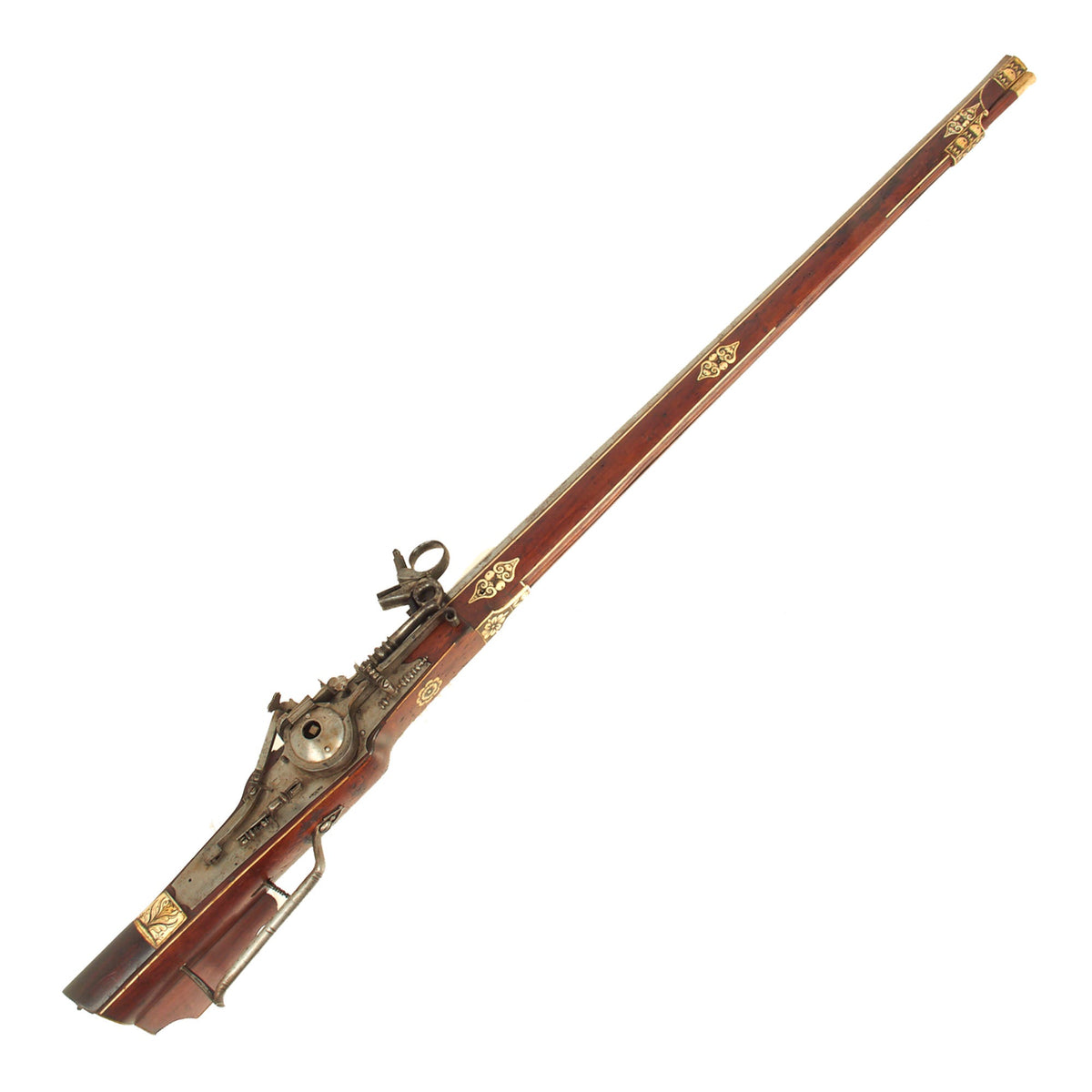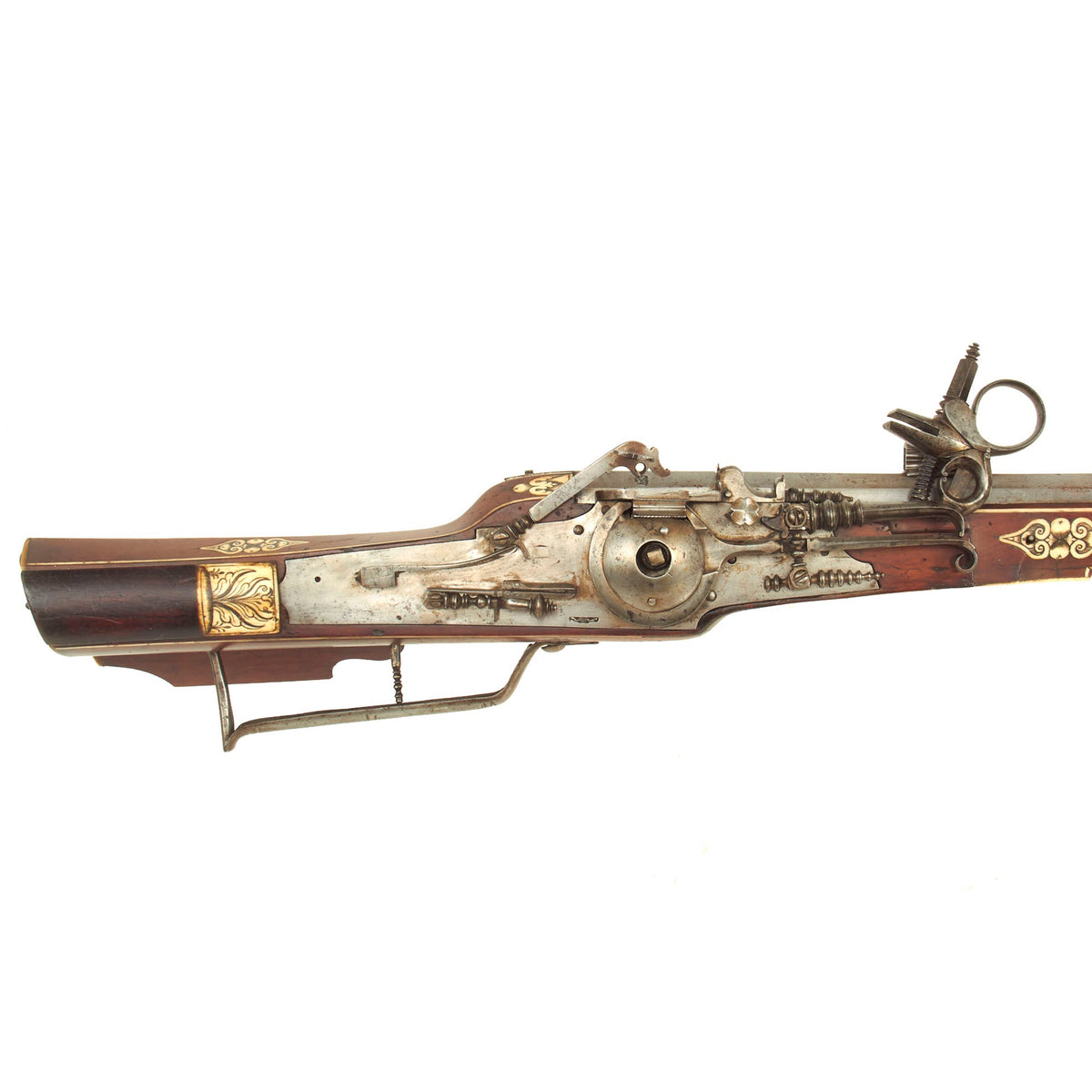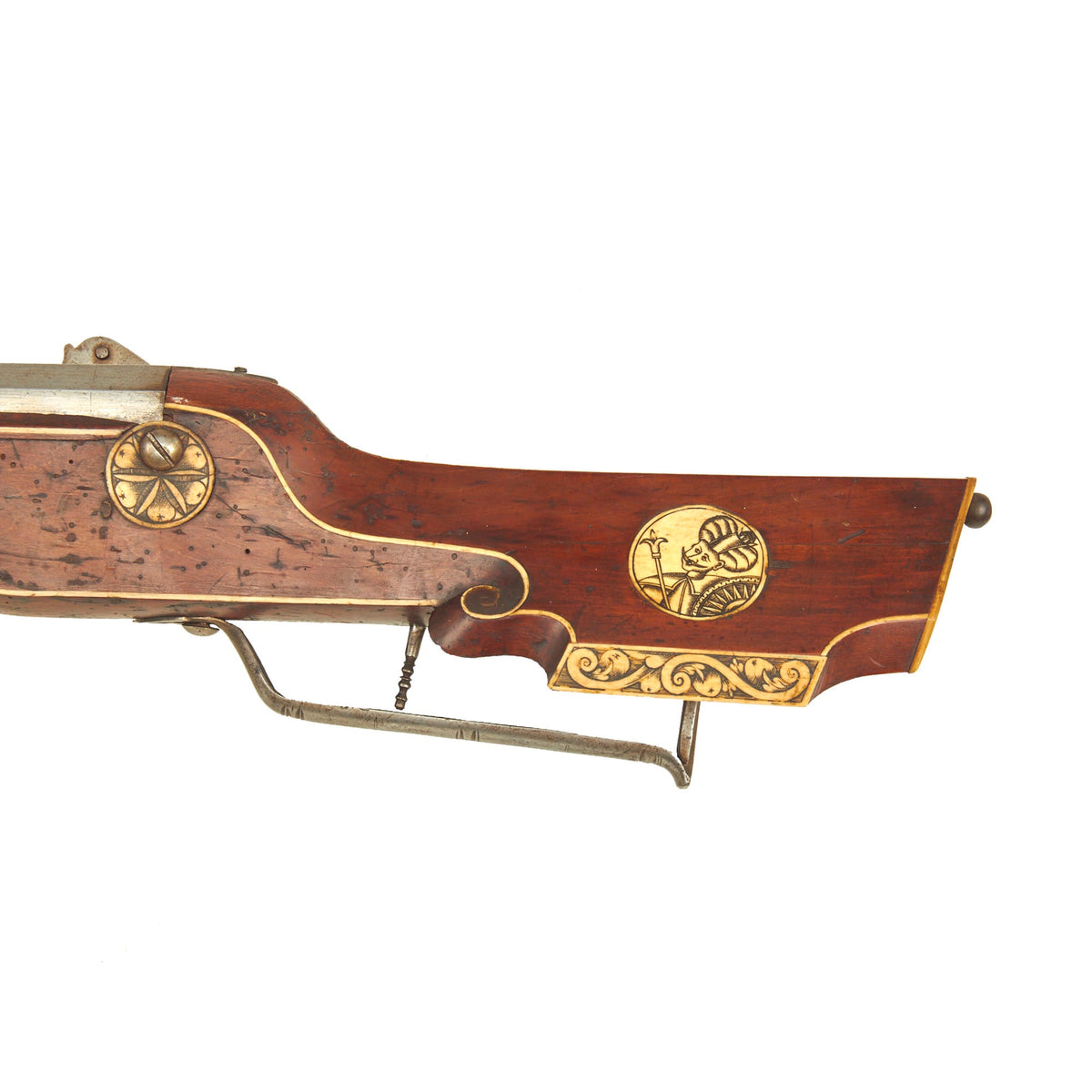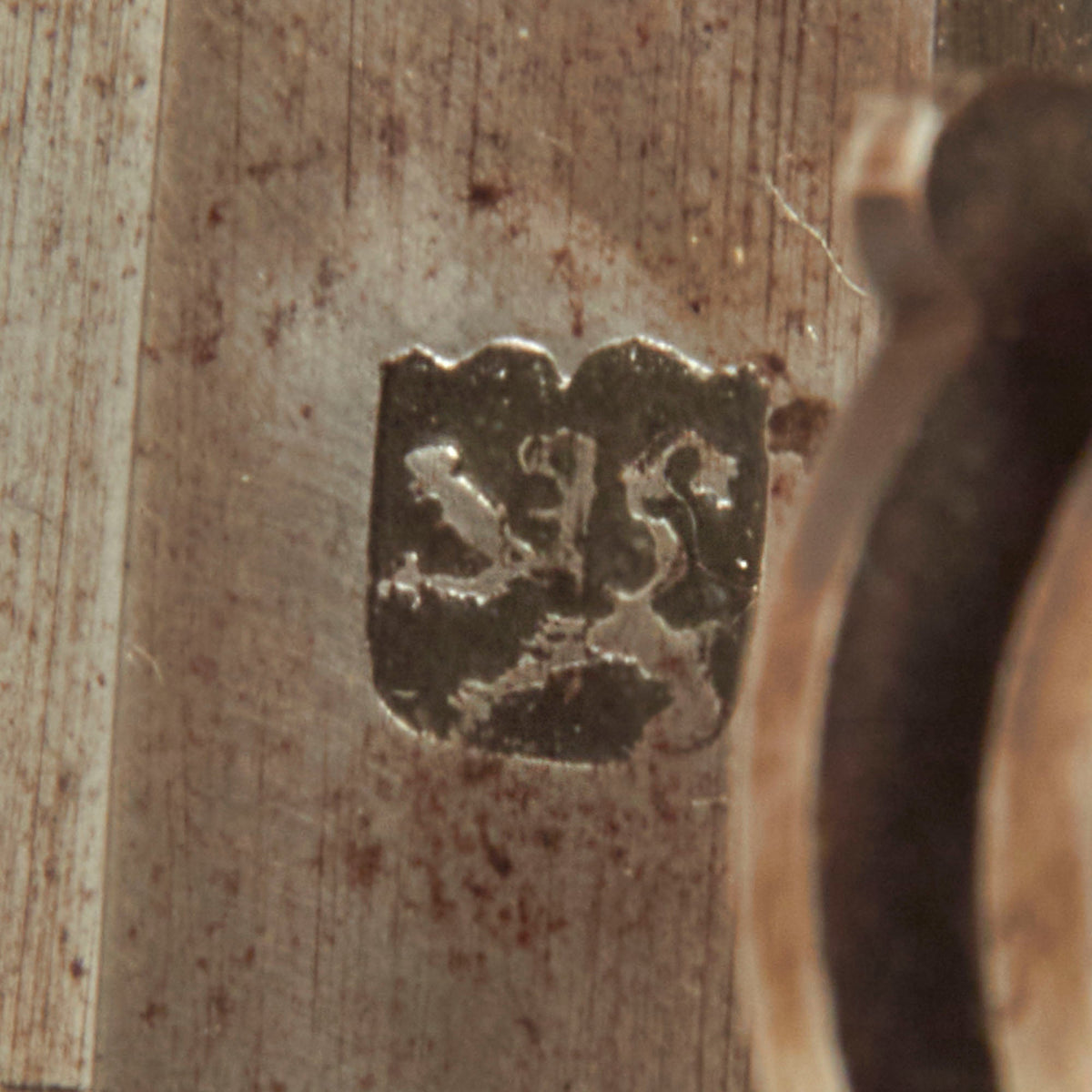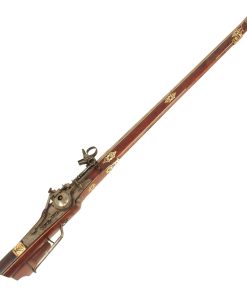Original Circa 1580 German Combination Wheellock Matchlock Gun with Engraved Inlaid Staghorn Original Items
$ 24.995,00 $ 6.248,75
Original Item: One-of-a-kind. Dating between 1580-1590 this is a fantastic example of a German manufactured combined wheel lock and matchlock musket comprised of a lovely full fruit wood stock with hand engraved inlaid stag horn plaques. The heavy walled octagonal barrel measures 40 inches in length and is struck with a makers mark of a lion inside a shield. The wheel-lock plate measures 12 inches and features a domed wheel cover. Overall the musket measures 52 inches and is offered in wonderful condition. There is evidence of old repairs and minor worm damage which is to be excepted from a 400 year old firearm. Both the matchlock and wheel-lock appear to be functional. Of particular note is the engraved stag horn panel on the left butt stock cheek piece depicting a Turk, or Ottoman, with turban and large mustache. Complete with original ram rod with horn tip and patch box with sliding cover. Overall a magnificent museum worthy example of an early firearm.
Though they provided more reliable ignition when properly maintained and functioning, the complex mechanisms used on wheellocks could fail with wear from extended use and fouling, and they could not be easily repaired. One solution to this incorporated both a wheellock and matchlock mechanism. This would allow the benefit of having a gun always at the ready when necessary but also allow for use as a matchlock if the wheellock mechanism was out of service or if the user had time to light the match and wanted to keep the wheellock mechanism in reserve.
Combination Wheellock Matchlock Guns were not uncommon in the mid to late 16th century with a few examples in the collections of some of the finest museums in the world including a very similar specimen currently at the Metropolitan Museum of Art which can be viewed this link.
Because they were primarily the arms of the elite, many wheellock firearms are very fine arms and are the work of multiple talented and specialized craftsmen. Their artistry and rarity has also made them a staple in the arms collections of many art museums around the world. They remained in use for over 200 years, and some black powder and historical reenactment enthusiasts still shoot them today.
Specifications:-
Year of Manufacture: Circa 1580 – 1590
Caliber: .55 inches
Ammunition Type: Lead Ball & Powder
Barrel Length: 40 inches
Overall Length: 52 inches
Action: Wheellock and Match Lock
Feed System: Muzzle-Loaded
A wheellock, wheel-lock or wheel lock is a friction-wheel mechanism which creates a spark that causes a firearm to fire. It was the next major development in firearms technology after the matchlock and the first self-igniting firearm. Its name is from its rotating steel wheel to provide ignition. Developed in Europe around 1500, it was used alongside the matchlock and was later superseded by the snaplock (1540s), the snaphance (1560s) and the flintlock (c. 1610s).
The wheellock works by spinning a spring-loaded steel wheel against a piece of pyrite to generate intense sparks, which ignite gunpowder in a pan, which flashes through a small touchhole to ignite the main charge in the firearm’s barrel. The pyrite is clamped in vise jaws on a spring-loaded arm (or ‘dog’), which rests on the pan cover. When the trigger is pulled, the pan cover is opened, and the wheel is rotated, with the pyrite pressed into contact.
A close modern analogy of the wheellock mechanism is the operation of a lighter, where a toothed steel wheel is spun in contact with a piece of sparking material to ignite the liquid or gaseous fuel.
A wheellock firearm had the advantage that it can be instantly readied and fired even with one hand, in contrast to the then-common matchlock firearms, which must have a burning cord of slow match ready if the gun might be needed and demanded the operator’s full attention and two hands to operate. On the other hand, wheellock mechanisms were complex to make, making them relatively costly.
NOTE: International orders of antique firearms MUST be shipped using UPS WW Services (courier). USPS Priority Mail international will not accept these. International customers should always consult their country’s antique gun laws prior to ordering.
Fast Shipping with Professional Packaging
Thanks to our longstanding association with UPS FedEx DHL, and other major international carriers, we are able to provide a range of shipping options. Our warehouse staff is expertly trained and will wrap your products according to our exact and precise specifications. Prior to shipping, your goods will be thoroughly examined and securely secured. We ship to thousands clients each day across multiple countries. This shows how we're dedicated to be the largest retailer on the internet. Warehouses and distribution centres can be located throughout Europe as well as the USA.
Note: Orders with more than one item will be assigned a processing date depending on the item.
Before shipping before shipping, we'll conduct a thorough inspection of the items you have ordered. Today, the majority of orders will be delivered within 48 hours. The delivery time will be between 3-7 days.
Returns
The stock is dynamic and we cannot completely manage it because multiple stakeholders are involved, including our factory and warehouse. So the actual stock may alter at any time. It's possible that you may not receive your order once the order has been made.
Our policy is valid for a period of 30 days. If you don't receive the product within 30 days, we are not able to issue a refund or an exchange.
You can only return an item if it is unused and in the same state as the day you received it. You must have the item in its original packaging.
Related products
Uncategorized
Uncategorized
Uncategorized
Australian WWII Owen MK1 Machine Carbine SMG Custom Fabricated Replica with Sling Original Items
Uncategorized
Uncategorized
Armored Burgonet Helmet & Polearm from Scottish Castle Leith Hall Circa 1700 Original Items
Uncategorized
Uncategorized
Uncategorized
Uncategorized
Uncategorized
Uncategorized
Uncategorized
Band of Brothers ORIGINAL GERMAN WWII Le. F.H. 18 10.5cm ARTILLERY PIECE Original Items
Uncategorized
Uncategorized
Angolan Rebel 1970s era 60mm Inert Display Mortar from Angolan Civil War Original Items
Uncategorized
Uncategorized
Uncategorized
Uncategorized
Uncategorized
Uncategorized
